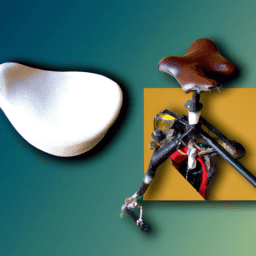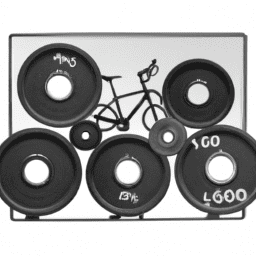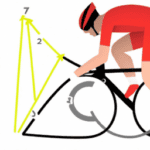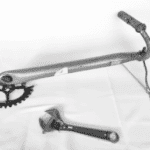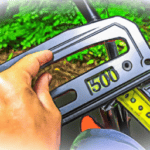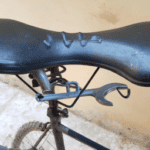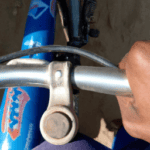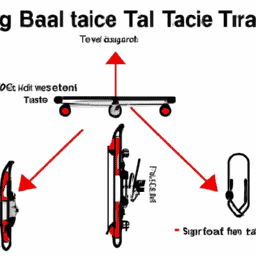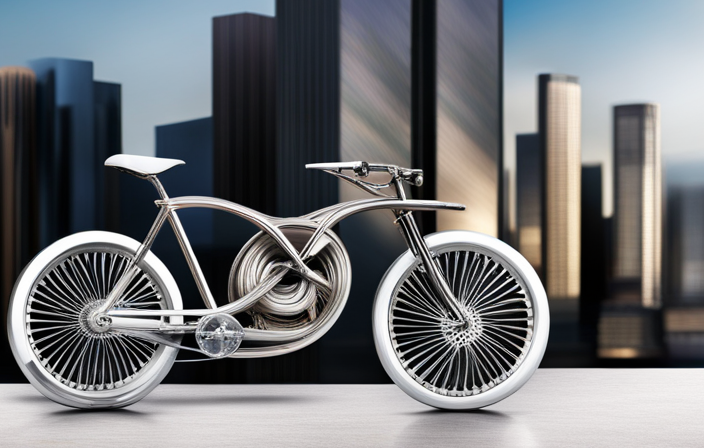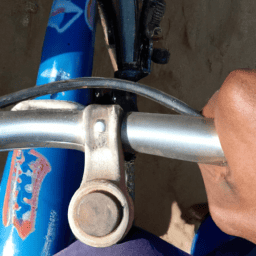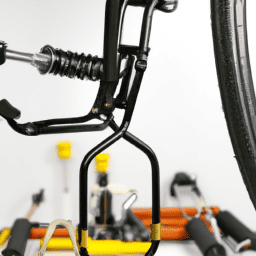As an experienced bike rider, I’m well acquainted with the discomfort that arises from spending lengthy periods on a bicycle seat. No matter if your cycling is for exercise, commuting, or enjoyment, a seat that isn’t comfortable can easily spoil your experience. However, there’s no need to worry, as there are multiple strategies to enhance the comfort of your bike seat and diminish the chances of experiencing pain or injury.
First and foremost, investing in a quality seat cushion can make all the difference. There are a variety of options available, from gel pads to memory foam, and it’s important to find one that works for you. In addition to providing extra cushioning, a good seat cushion can also help distribute your weight more evenly and reduce pressure points.
But comfort isn’t just about the cushion, there are several other adjustments and measures you can take to improve your riding experience.
Key Takeaways
- Quality seat cushions such as gel pads or memory foam can make a significant difference in bike seat comfort.
- Adjusting seat height, tilt, and angle can enhance comfort by allowing for full leg extension, reducing pressure on sit bones, and finding the right fit for the rider.
- Additional cushioning such as padded shorts or pants made from synthetic or natural fibers can provide extra comfort and prevent chafing or skin irritation.
- Regular bike maintenance including cleaning, checking tire pressure, and following manufacturer recommendations can ensure optimal performance and a comfortable ride.
Invest in a Quality Seat Cushion
If you want to make your bike seat more comfortable, you should invest in a quality cushion. The right cushion can make all the difference, especially if you spend a lot of time on your bike.
When choosing a cushion, there are a few important factors to consider. First, you want to make sure you choose the right material. There are a variety of materials to choose from, including memory foam, gel, and synthetic materials. Each material has its own benefits and drawbacks, so it’s important to do your research and choose the material that will best suit your needs.
In addition to choosing the right material, you also want to make sure that you choose a cushion that fits your bike seat properly. A cushion that is too small or too large for your seat will not provide the necessary support and may even make things worse. Take the time to measure your bike seat and choose a cushion that fits snugly and securely.
With the right cushion, you’ll be able to enjoy your bike rides for longer periods of time without experiencing discomfort. Speaking of comfort, another way to improve your cycling experience is by adjusting the height, tilt, and angle of your seat.
Adjust the Height, Tilt, and Angle of Your Seat
Properly adjusting your seat’s height, tilt, and angle can significantly enhance your biking experience. Here are some tips to help you get started:
-
Determine your seat height: The ideal seat height allows you to fully extend your leg when the pedal is at the bottom of the stroke. To get an accurate measurement, wear your cycling shoes and place your heel on the pedal. Adjust the seat height until your leg is fully extended without rocking your hips.
-
Check the tilt: The tilt of your seat affects the pressure on your sit bones. A level seat is ideal, but some riders prefer a slight tilt forward or backward. Experiment with small adjustments until you find the most comfortable position.
-
Adjust the angle: The angle of your seat can also impact comfort. A seat that’s angled too far up or down can cause discomfort or even pain. Make small adjustments until you find the angle that feels best.
-
Consider different seat types: Not all seats are created equal. Different seat shapes and materials can affect comfort. Some riders prefer a wider or narrower seat, while others prefer a softer or firmer material. Experiment with different seat types until you find the one that works best for you.
If adjusting your seat doesn’t provide the comfort you need, consider professional fitting options or investing in padded shorts or pants. These can further improve your comfort and help you enjoy your ride even more.
Wear Padded Shorts or Pants
Enhance your riding experience by wearing padded shorts or pants, which can provide additional cushioning and support for your body during long rides. The benefits of padded shorts include reducing friction and chafing, regulating body temperature, and preventing skin irritation. They also distribute pressure evenly across your body, which helps reduce discomfort and fatigue.
When choosing padded shorts, it’s important to consider the type of fabric used. Look for materials that are breathable, moisture-wicking, and quick-drying. Synthetic fabrics like polyester and spandex are popular choices because they’re stretchy, durable, and lightweight. Natural fibers like cotton and bamboo are also good options because they’re soft, comfortable, and eco-friendly. Keep in mind that some fabrics may be more suitable for certain weather conditions or activities, so it’s important to choose the right one for your needs.
Transition: While padded shorts can provide extra comfort during your ride, it’s still important to take breaks and stretch regularly to prevent stiffness and injury.
Take Breaks and Stretch Regularly
Taking breaks and stretching regularly can prevent stiffness and injury during long rides. As a cyclist, I know firsthand the importance of taking breaks and stretching my muscles. Not only does it prevent soreness and injury, but it also allows me to enjoy the ride even more.
Here are some benefits of stretching:
- Stretching improves flexibility, increases blood flow to the muscles, and helps prevent muscle soreness and injury.
And the best time to take a break:
- Take a break every hour or so, or whenever you feel fatigued. It’s important to listen to your body and not push yourself too hard.
By taking breaks and stretching regularly, you can avoid muscle stiffness and injury during long rides. But it’s not just your body that needs maintenance – your bike does too.
Maintain Your Bike
Make sure your bike is in good condition by regularly maintaining it. One of the ways to ensure that your bike is in tip-top shape is by cleaning it regularly. Dirt and grime can accumulate on and around the seat, making it uncomfortable to ride. By keeping your bike clean, you can prevent this from happening and make your ride more enjoyable.
Use a soft cloth or sponge, and mild soap and water to clean the seat and other parts of your bike. Avoid using abrasive cleaners or scrubbing too hard, as this can damage the surface of the seat.
Another aspect of maintaining your bike is checking the tire pressure. Proper tire pressure is important for a comfortable ride, as well as for safety. When the tire pressure is too low, it can make the ride bumpy and uncomfortable. On the other hand, when the tire pressure is too high, it can make the bike feel stiff and less responsive.
Check your bike’s tire pressure regularly, and adjust it if necessary. Your bike’s manual or the tire sidewall should have information on the recommended tire pressure. By maintaining your bike and checking the tire pressure, you can make your ride more comfortable and enjoyable.
Frequently Asked Questions
How do I know if my bike seat is the right size for me?
To determine the right bike seat sizing for me, I measure the distance between my sit bones. I then select a saddle based on my measurements and riding style to ensure a comfortable fit and avoid discomfort or pain while riding.
Can I use a gel seat cover instead of a quality seat cushion?
Using a gel seat cover instead of a quality foam cushion is a personal preference. Gel can provide more cushioning, but may not be as breathable. Investing in a quality foam cushion is worth it for optimal comfort and longevity. Properly cleaning and maintaining your bike seat cover is important for both gel and foam options.
How do I adjust the tilt and angle of my bike seat?
To adjust the tilt and angle of my bike seat, I first measure my preferred seat height and position. Then, I loosen the bolts and angle the seat to my liking. I also explore different types of bike seats and designs to find the most comfortable option.
What are some recommended stretches to relieve discomfort while biking?
To relieve discomfort while biking, I recommend stretching before and after rides. Focus on stretching your hamstrings, hip flexors, and lower back. Maintaining proper cycling posture and staying properly hydrated can also greatly improve comfort.
How often should I replace my bike seat?
I understand the concern about replacing a bike seat, but factors such as usage and materials can affect its lifespan. Upgrading your bike seat for performance may also be beneficial. It’s important to regularly check for wear and tear to ensure optimal comfort.
Conclusion
In conclusion, making your bicycle seat more comfortable is a matter of investing in quality equipment, making adjustments to the height, tilt, and angle of your seat, wearing padded shorts or pants, taking breaks and stretching regularly, and maintaining your bike.
But, before you rush out to buy the latest seat cushion or invest in expensive gear, it’s important to investigate the truth behind some common myths and theories about bicycle seat comfort.
One theory is that wider seats are more comfortable, but research has shown that a narrow seat can be just as comfortable if it’s properly adjusted and supported. Another theory is that soft seats are more comfortable, but a firmer seat with proper support can actually be more comfortable in the long run.
By understanding the truth behind these theories and applying the right techniques, you can make your bicycle seat more comfortable and enjoy your rides more fully.
So, get out there and ride with confidence!
